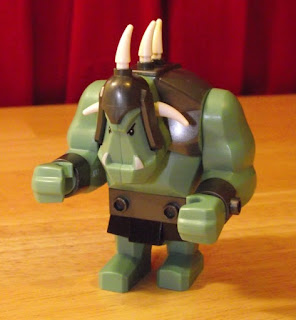Size Categories
If you play D&D or Pathfinder, creatures larger than Medium size take up more than one 5-foot square on the battle map. In most cases, you will want to put your model on an appropriately-sized base in order to clearly mark what space it occupies. A round base is often preferable to a square one, so that you can easily turn the model without any corners sticking out into other squares. (However, given the nature of LEGO bricks, squares and rectangles are much easier to find!)
 |
| Girallon (modified Yeti minifigure) |
I find it useful to have a few extra Large and Huge bases handy during play so that I can place them under miniatures that don't already have a standard-sized base. For example, I own a number of plastic animal toys that I use for creatures of which I don't own LEGO versions, so I'll put the toy on top of a LEGO plate to show its proper size category. Also, if a creature changes size during an encounter, I can put its miniature on a different sized base to show that.
 |
| Giant troll (Castle) |
Big Figures
Over the years, a number of oversized characters have been produced for various LEGO themes. The more-or-less humanoid characters of this type include:
- Adventurers: Jun-Chi (a lion-dog spirit), Tygurah (a tiger deity), Yeti.
- Castle: Giant Troll.
- Harry Potter: Hagrid (near minifigure scale), Troll.
- Legends of Chima: Mungus (Mammoth Tribe).
- The Lord of the Rings/The Hobbit: Cave Troll, Goblin King.
- Ninjago: Dogshank (giant pirate).
- Power Miners: Eruptor, Geolix, Tremorex (three rock monsters).
- Rock Raiders: Rock Monster.
- Star Wars: Rancor, Wampa.
- Superheroes: Darkseid, Gorilla Grodd, Hulk, Green Goblin, Thanos.
- Teenage Mutant Ninja Turtles: Dogpound, Leatherhead.
Using one of these "Big Figures" gives you a well-defined large character, but they are usually only available as part of larger sets, and those sets tend to only be available through retail for a year or two at most. Many of these figures are available through websites such as Bricklink, where you can expect to pay anywhere from $5-$10 for a smaller, more common character, up to $35+ for a Rancor. Another drawback of these figures is that they have few parts for their size, and few free studs, so are hard to customize. Also, most of them are very specific licensed characters, which may be distracting if you want to use them to represent other monsters. For example, my pair of Harry Potter trolls see frequent use as ogres and giants, but my Hulk is a little too, well, Hulk-ish for that.
A related option is using Duplo figures for giants. These characters are a good scale for depicting Large humanoids, but are rather more silly-looking than scary. Also, unless you buy them individually through a reseller, you will end up with several oversized bricks as well. Duplo bricks are fully compatible with regular LEGO bricks (being exactly twice their dimensions) but they aren't nearly as useful for small-scale models.
 |
| Ogre (modified minifigure) |
Modified Minifigures
If Big Figures are out of your price range or don't cover the monster you need, then you'll need to build your own model. The easiest way of doing this is to modify a minifigure to make it a little bigger, then put it on a base appropriate to its size category.
Some of the collectible Minifigures, such as the Minotaur, Cyclops, and Frankenstein's Monster, already represent creatures that would be larger than human-scale in D&D or Pathfinder. You can simply put these minifigures on a larger base to indicate their true size. (The 3x4 plate that comes with each one will serve well enough for this.)
You can also make a minifigure taller by standing it on two 1x1 bricks, and taller yet by inserting a 1x2 brick between the torso and legs (as was done for the ogre shown here). These changes leave the arms rather short in proportion to the rest of the body, but a larger weapon can help offset that.
Building from Scratch
The other option is to build a custom model yourself. The photo below shows two Large giant models, one very simple and the other more advanced, with a minifigure for scale. The one on the left is just a stack of bricks with an antenna for a weapon. (If you lack cylinders and slope bricks, simply replace them with standard bricks.) The result is rather crude, but conveys the creature's size and general humanoid shape.
The giant on the right is more detailed, with a few articulated joints allowing it to be posed. The next photo shows the subassemblies better. The right leg uses a slope brick to extend forward, as if taking a step. The shoulders are 1x1 bricks with a stud on one side. (You can also use "headlight" bricks, but you'll need to stick 1x1 plates over the recessed side-studs in order to attach the arms.) A 1x2 jumper plate provides a centered stud for attaching the head.
Experiment with different colors and pieces to change this base model into the kind of giant you need: brown and tan bricks for ogres and hill giants, green for trolls, gray for stone giants, white and blue for frost giants, red for fire giants, etc., with contrasting colors for clothing and armor. Bricks with side-studs can be used to attach additional plates and tiles for hair, beards, or armor, or simply to add bulk to the torso.


These are very interesting and awesome. 10/10.
ReplyDelete